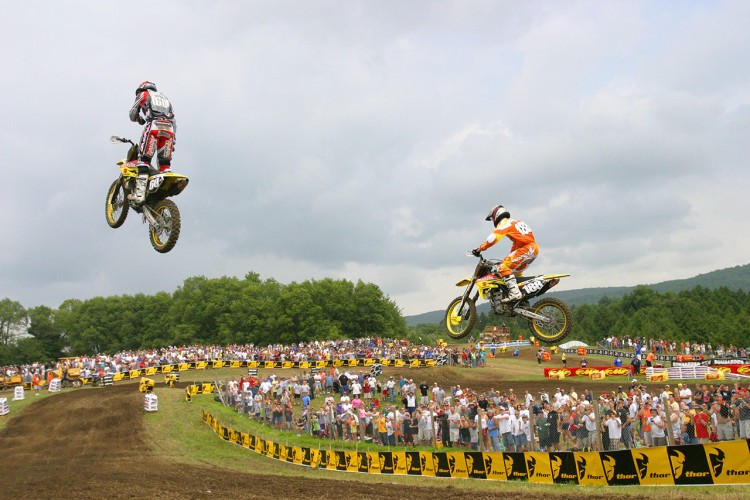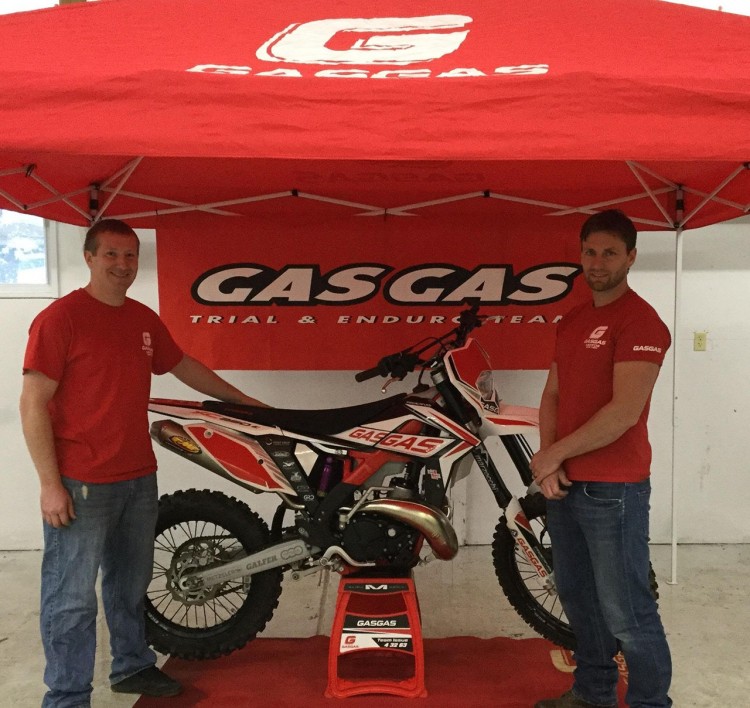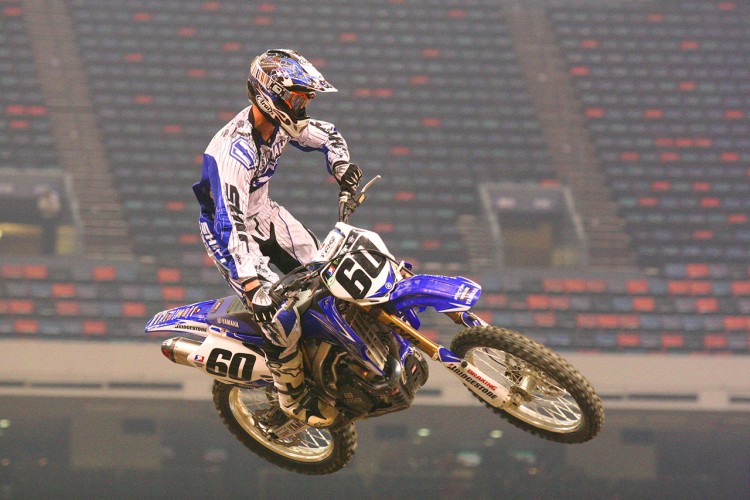INTERVIEW OF THE WEEK: BROC HEPLER
 Broc Hepler (60) jumps past Davi Millsaps (188) at the Unadilla National in 2005 for the lead and eventual overall win. It was his first of five 125 National overall wins.
Broc Hepler (60) jumps past Davi Millsaps (188) at the Unadilla National in 2005 for the lead and eventual overall win. It was his first of five 125 National overall wins.
By John Basher
January 25, 2007–the day Broc Hepler’s life was forever changed. The newly-signed factory Yamaha star was coming off a solid year in 2006, having won three straight Nationals before departing from the Makita Suzuki factory team. Hepler, a native of Pennsylvania, was preparing for what was supposed to be a title-winning Supercross series in the 250 East. However, on January 25th, he washed his front end out on the landing of a double at the Yamaha Supercross test track. The fall happened so quickly and unexpectedly that Hepler never had time to take his hands off the bars. He suffered blunt force trauma to his brain and was out cold for over seven minutes.
Sure, Hepler came back and raced in 2007 through ’09, but he was never the same. Hepler never won another race, and he failed to complete a full race series following the crash. To this day Broc suffers from fogginess as a result of his concussions. Hepler hasn’t merely faded into obscurity, though. He still rides–in fact, Broc just inked a deal with Gas Gas to compete in East coast Enduro races–and he’s also unafraid to express his views on concussions via social media. For those reasons, I wanted to find out what Hepler has been up to, and get a better understanding of the effects of concussions. Heed his advice.
 Hepler (left) and Johnny Barber, Gas Gas’ East Coast Promotions guru, inked a deal for Broc to race Enduro for the 2016 season.
Hepler (left) and Johnny Barber, Gas Gas’ East Coast Promotions guru, inked a deal for Broc to race Enduro for the 2016 season.
How often do you ride these days? Not enough, actually [laughter]. We’re snowed in at the moment. There’s about eight inches of snow on the ground. This past year I would ride whenever my buddies wanted to go out, which was about every other week or so. I need to start putting more effort into riding if I actually want to compete this year. Since the beginning of the year I started doing some training in the gym. The Gas Gas thing was in the works, so I’m preparing myself to be ready for racing.
Did the fact that Ryan Sipes became the first American to win the ISDE overall last year give you any motivation to race the prestigious event? Yeah, it gives everyone hope that America can do it. The year before Ryan was on the Club team. They’re not just going to throw me on the Trophy team. I need to prove myself and show everyone that I have it. Possibly down the road I can get on the premiere team if I do well. I’d like to work my way up. That would be neat. It would be cool to do the ISDE this year. It’s in Spain this year, and that’s where Gas Gas is from. Gas Gas just signed me to race East coast Enduro races and things like that. Geoff Aaron is riding for Gas Gas on the West coast.
Recently you tied the knot. What else is new in your life? I got married July 18th of this past year. I graduated about a year ago with a health and physical education degree. It’s a tough spot trying to find work, because there’s usually only one male gym teacher per school. I haven’t found a permanent spot yet, but I’ve been doing quite a bit of substitute teaching.
Do you have any lingering effects from hitting your head? Yes. I am still having problems. My wife is putting the hammer down on me. She told me that I’m not allowed to do any reading before I go ride or race.
What does reading have to do with concussions? When I substitute teach, usually I give the kids a work sheet. To pass the time I’ll read a book or magazine while the students are working. Doing that scanning or reading will bring on the symptoms of fogginess. This year I’ll have to cut out the reading, because I don’t want my brain to be foggy when I’m going racing.
 Broc Hepler scored a third at the New Orleans Supercross in 2009. Less than two months later he would suffer a concussion at the Las Vegas Supercross and retire from racing.
Broc Hepler scored a third at the New Orleans Supercross in 2009. Less than two months later he would suffer a concussion at the Las Vegas Supercross and retire from racing.
So the scanning motion with your eyes brings on the fogginess that you speak of? Yes, ever since 2007 at the Yamaha Supercross test track. The fogginess came after I hit my head there. Fortunately the fogginess is a lot better than it used to be, but it’s still there if I read or do exercises with a lot of head movement. Sit-ups really cause problems, because my head moves up and down rapidly.
Do you have any other symptoms that flare up? Fogginess is the main one. It’s a big problem, because it slows my reaction time on the bike. If I tried to race Supercross then my timing would be off. I wouldn’t be able to jump cleanly, and I’d be landing on hay bales. It wouldn’t be good.
You mentioned your big crash at the Yamaha test track in 2007. I did some research on the day’s events, but nothing seems clear about what happened. Do you remember anything from that day? How long were you knocked out? It happened a few weeks before the East Coast Supercross series was starting, and I was putting in laps at the Yamaha Supercross test track. I fell and was knocked out for 7-1/2 minutes. I assume that I was taken to Riverside hospital and was there for three days. I still can’t recall what happened at the track or while I was at the hospital for those three days.
Following that concussion, you hit your head in practice at Anaheim in 2009, and then in practice at the Las Vegas Supercross that same year. Did you suffer from any more concussions during your career? There was probably one when I broke my collarbone while racing at Budds Creek as an amateur. It was around October of 2002. For five years I was okay, but then I had that really bad concussion in 2007. You bring up 2009 and those problems. You also need to look at the year before, in 2008. I made a few races on the West Coast, but then I broke my thumb. I came back and won the Navy Moto-X Games in San Diego. A few weeks after that I broke my elbow and made a comeback for the last three outdoors. I got a podium at Steel City. Then at Anaheim in 2009 I hit my head and broke my collarbone. That was three surgeries in a year, and I also had hit my head. I finally realized all those wrecks were caused by my brain not being able to keep up with the speed and demand that it needed to perform at.
 Hepler was a valued addition on Roger DeCoster’s Makita Suzuki factory team. DeCoster had high expectations for Hepler, and Broc followed Roger’s advice. Two years later the duo split when Hepler signed a high-dollar Yamaha contract.
Hepler was a valued addition on Roger DeCoster’s Makita Suzuki factory team. DeCoster had high expectations for Hepler, and Broc followed Roger’s advice. Two years later the duo split when Hepler signed a high-dollar Yamaha contract.
At the end of 2009 you weren’t interested in a Supercross deal for 2010, but racing the Nationals still seemed enticing. Did you truly believe that you would be healthy enough to race the Nationals, or were you simply kidding yourself? After Las Vegas I was never right. I knew that I couldn’t continue with the way I was feeling, and I never wanted to feel that bad again. I’m sure that I would have been able to find a ride and still make a good bit of money for the Nationals in 2010. However, I want the current group of professional riders to see that I could have made a lot of money and still gone racing, but it wasn’t worth the risk to harm my health for the rest of my life. To fully answer your question, I didn’t seek out a ride for 2010 or even talk to anyone about racing again. In January 2010 I started taking college courses. I knew my racing career was over.
Was it hard to give up racing professionally? On one hand, you suffered from a rash of serious injuries. On the other, you were making good money and racing was what you had dedicated your life to. No matter how good you are, you could have always done things better or won more. Obviously I didn’t win a championship, which would have been an awesome goal to achieve. Looking back, I did win races. I actually have a pretty good statistic. I made it into the Armstrong County Hall of Fame here in Pennsylvania, and I had to provide them with some of my racing accomplishments. I learned that during my six-year career, for 2004 to 2009, and the three Pro races I did in 2003, I only did 74 professional races, but I podiumed 25 times. I had over a 33-percent rate of finishing on the podium.
Looking back, your 2004 race season was incredible. You finished third in the 125 East, and second in the 125 National standings. If not for James Stewart, you would have won the outdoor crown. It was a good year for me. My podium percentage that year was really high. I’m proud of my stats. Going back to what you asked, it would have been amazing to win a championship, but there came a point when it wasn’t worth the risk anymore.
 Hepler took to Instagram after the Oakland Supercross and weighed in on James Stewart’s concussion.
Hepler took to Instagram after the Oakland Supercross and weighed in on James Stewart’s concussion.
You had this to say about James Stewart’s health status regarding concussions, “I know James made the right decision to pull off last weekend [in Oakland], so hopefully the ones who think otherwise will reexamine their incorrect theories.” Is the severity of a concussion downplayed too much? The Asterisk medical crew are doing the best that they ever have in terms of making the riders pass the ImPACT testing. Still, it’s all up to the rider. Even the NFL, if you pass the concussion protocol you can go play, but the doctors cannot see your symptoms. So you might be able to pass the test, but you’re the only one who knows if you have fogginess or headaches. Doctors can’t test for those things. If you’re lying to yourself just so you can go ride, then you’re only hurting yourself. At the same time, it’s hard for a rider to tell the truth, because they want to race in order to make more money, do well for their team, and have a future. If the doctor tells you that you’re good enough to ride then it’s a difficult decision for the rider to make.
What have you learned about concussions through your research and in working with the UPMC Sports Medicine Concussion Program? As far as I know, they’re the creators of the ImPACT testing. It was good that I had a baseline setting before my concussion in 2007. I know that in 2007 the ImPACT test wasn’t mandatory yet in professional racing. UPMC had prior knowledge of what my reaction times and cognitive and memory baselines were, so I had my own protocol. I’m fortunate to have worked with them.
Is there any way the Impact test can get to the point where it would take the guesswork out of whether a rider is truly ready to race following a concussion? I would hope so. What’s interesting about talking to you today is that I was substituting for a health class this morning. I played the students a video about brain injuries in the NFL. The video spoke of CTE (Chronic Traumatic Encephalopathy). All these NFL players are donating their brains after they die, and then doctors can see what percentage of brain trauma the players had. They can’t test that while the athlete is alive. It would be neat if, at some point, doctors could test for concussions and CTE before a rider or player competes again. Maybe that can be the next step.
Do you still follow the racing? Yeah. I stay up usually until midnight or 1:00 a.m. to watch the races. I’m still that involved in it. I enjoy watching the races, even though I’m not in it at the same level that I used to be.
 Broc Hepler and James Stewart have been friends and competitors. Stewart took time on the podium to congratulate Hepler on his first (and only) 450 Supercross podium at New Orleans.
Broc Hepler and James Stewart have been friends and competitors. Stewart took time on the podium to congratulate Hepler on his first (and only) 450 Supercross podium at New Orleans.
So then you saw James Stewart suffer a concussion at Anaheim 1. James has a long history of concussions. What are your thoughts on guys like Stewart or RJ Hampshire? James can be the fastest rider on the track all by himself and not take many risks. Whenever you had other riders in and race head-to-head, you can’t always be the safest rider. For that reason I worry about myself when I’m racing. I don’t race GNCC’s, because other people can hit me. When I race enduro I am all by myself. I know I can still wreck, but I’m okay with crashing by myself rather than having someone else injure me. That’s where I stand with riders that have had a lot of concussions already. They’re putting themselves at risk just by riding a dirt bike, but then you add in a bunch of other riders on the track. Things are beyond your control. I watched the Oakland Supercross, and I could tell that James’ timing was off even in the heat race. He wasn’t doing the rhythm sections cleanly. I had a feeling that’s how I would look if I was riding that same track. Obviously James would look better than me, because he has always been faster than me. I had it in my heart that James was going to pull off. I’m glad that he did.
What are your recommendations to those who have sustained a concussion? Be as symptom-free as you can be before riding again. The more severe your symptoms are then the more you’re at risk of another head injury. You basically shouldn’t be riding if you have any symptoms. People ask me how they can come back quicker after having a concussion. The truth is that you really can’t. I could hit my head at the exact same speed and angle that you did, but you might be able to ride in three weeks. It might take me three months. That’s why it’s so hard for the doctors to provide any kind of timeframe. That’s why we don’t see much information from James about when he will be back racing. He probably doesn’t know. These things just take time. It’s not like a broken bone that will heal in six-to-eight weeks.
Do you ever look back on your racing career and think, What if? Sure, I do. That crash was the beginning of the end for me. Looking at my stats before that crash, I had a lot of wins and great rides. After that crash I was a hit or miss. On certain nights I would finish on the podium, but it depended on the day. Some race days I would feel really good, but the next day I would struggle with concussion symptoms. I never knew what to expect.
You spoke during the 6D helmet unveil and talked about your history with concussions. Now that the technology has been out a few years, what are your thoughts on helmet advancements in concussion prevention? It’s great that helmets have improved. I supported 6D, and I wear their helmet. It’s awesome that they were the first company to step up. I would still like to see a more involved test. I know that we have the DOT and Snell tests, but I would like to see a comparison of every helmet. Helmet testing should be public knowledge so we know exactly what every helmet’s results are. Tests should be done on different surfaces, too. A lot of those helmet tests are done with a sphere or something that’s basically worthless to a motocross rider. It’s great that helmet companies have stepped up, but there needs to be more public information.
Thanks for your time, Broc, and congratulations on the Gas Gas ride. Thanks, John.





Comments are closed.